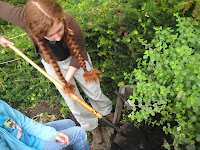We harvested lots of onions and carrots.

As well as many red and green tomatoes.

Tomatoes need to be harvested, even if still green. If left on the plant during cool temperatures and rain they will develop blight and turn black instead of red. Wrap your green tomatoes in newspaper and store them in a cool dark place until they ripen.

Tomato plants were then removed and put in our yard waste bins for composting (blight may spread in a cold composter, but in Vancouver yard waste is mechanically composted using heat).
We also planted some more fall crops (many winter crops should be planted in July or August, but due to extreme heat on our roof in these months not many seedlings were started successfully)
We planted overwintering broccoli starts, kale seeds and garlic after amending the soil with compost from our worm bin composter.



Garlic is grown by separating the cloves of the garlic bulb and planting pointy-end up roughly 4 inches deep in the soil. Each clove will form a new bulb. We simply bought local organic Red Russian garlic from a nearby grocer.
Happy autumn!
- marnie












